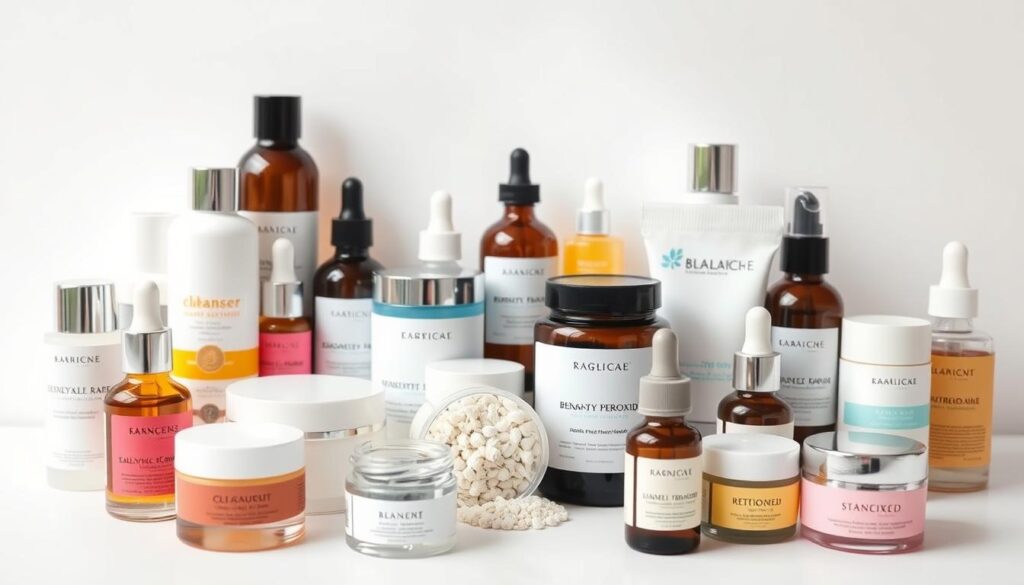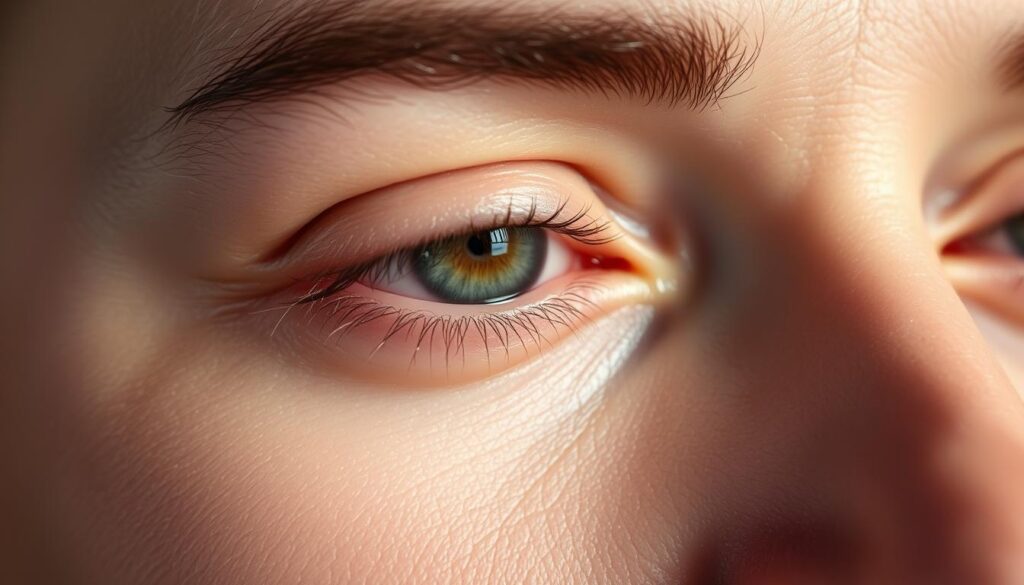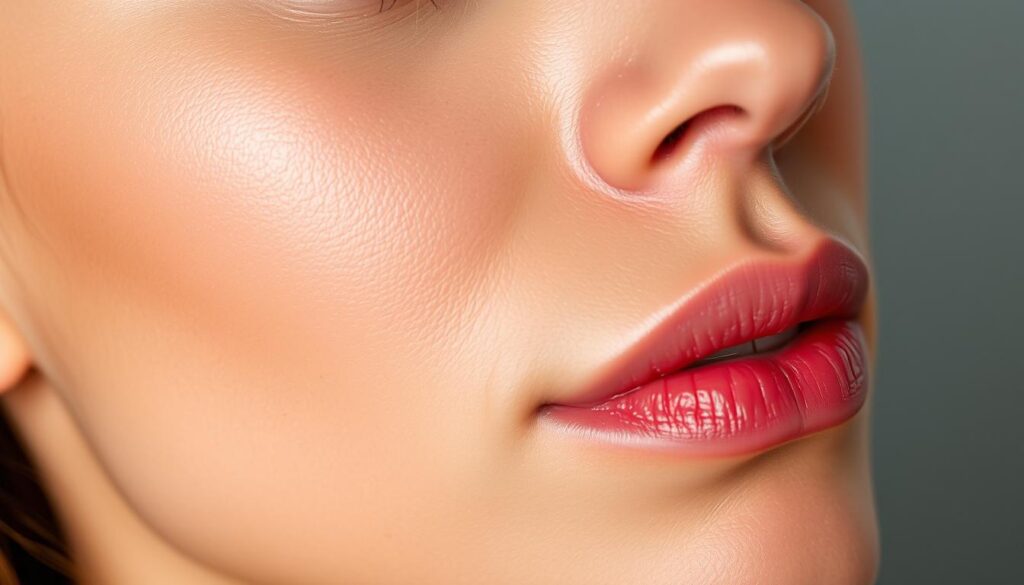Dealing with skin issues can be frustrating, especially when they’re tied to internal changes. Hormonal acne is a common concern that often appears during puberty or adulthood. It’s caused by an overproduction of sebum, which can lead to various skin problems, from blackheads to cysts1.
This type of acne can significantly impact your confidence and quality of life. Understanding the root causes, like hormonal shifts, is the first step toward effective management1. Whether you’re experiencing mild or severe symptoms, finding the right treatment is essential for clearer skin.
In this article, you’ll discover practical strategies to address hormonal acne. We’ll explore symptoms, triggers, and proven remedies to help you take control of your skin health. Let’s dive into the details and find solutions that work for you.
Understanding Hormonal Acne
Understanding the root of skin concerns can make managing them easier. This type of issue often differs from others due to its connection to internal changes. It’s not just about what’s on the surface but also what’s happening inside your body.
Recognizing the Signs and Symptoms
Common signs include inflammation, cysts, and persistent breakouts. These often appear in areas like the T-zone—forehead, nose, and chin2. Women are three times more likely to experience flare-ups related to hormonal changes, especially during their menstrual cycle3.
Other symptoms can include whiteheads and blackheads. These are often linked to an overproduction of oil in your hair follicles and glands. Knowing what to look for can help you address the issue effectively.
Identifying Common Triggers
Several factors can contribute to this condition. Hormonal fluctuations, stress, and certain skincare products are key triggers2. For example, high-glycemic foods and dairy may affect insulin and androgen levels, leading to skin problems4.
Here are some typical triggers to watch out for:
- Hormonal changes: Menstruation, pregnancy, or menopause can cause imbalances3.
- Stress: Increased stress levels can worsen symptoms.
- Skincare products: Some products may clog pores or irritate your skin.
By understanding these triggers, you can take steps to minimize their impact on your skin.
Common Causes and Effects on Your Skin
Your skin’s health is deeply connected to internal factors, especially hormones. When these hormones are out of balance, it can lead to visible changes on your face. Understanding these connections can help you address the root causes of skin concerns effectively.
The Role of Hormones in Skin Issues
Hormones like androgens play a significant role in regulating oil production in your skin. When these hormones are imbalanced, they can cause your pores to produce excess sebum. This overproduction can lead to clogged pores and inflammation, resulting in breakouts5.
Women are particularly susceptible to these changes due to hormonal fluctuations during menstruation, pregnancy, or menopause6. These shifts can make your skin more prone to irritation and breakouts.
How Hormonal Imbalances Affect Pore Health
Hormonal imbalances can directly impact the size and function of your pores. Excess sebum production can stretch your pores, making them appear larger and more noticeable. This can also trap dirt and bacteria, leading to inflammation and breakouts5.
Here’s how hormonal changes affect your skin:
- Increased sebum production: Hormones like androgens can trigger your oil glands to produce more sebum.
- Clogged pores: Excess oil can mix with dead skin cells, blocking your pores.
- Inflammation: Blocked pores can become inflamed, leading to redness and irritation.
Compared to other causes, hormonal imbalances are often more persistent and require targeted treatments. For example, retinoids are a common medication used to unclog pores and promote skin cell turnover6. These treatments can help manage the effects of hormonal changes on your skin.
Hormonal Acne: How to Treat and Prevent Breakouts
Managing skin concerns requires a balanced approach that combines daily care with professional advice. A multifaceted strategy can help you achieve clearer and healthier skin over time. By understanding the right products and routines, you can take control of your skin health effectively.
One of the most effective ways to address skin issues is through a combination of treatments. Over-the-counter products like salicylic acid and benzoyl peroxide are great options for reducing inflammation and unclogging pores7. These products are available in various strengths, making them suitable for different skin types8.
Daily skincare routines play a crucial role in maintaining healthy skin. Washing your face twice a day with a mild cleanser can help keep pores clear and reduce breakouts9. Applying acne treatment products in a thin layer ensures they work effectively without causing irritation8.
Consulting a dermatologist is essential for personalized care. They can recommend prescription options like retinoids or anti-androgens, which are proven to be effective for long-term prevention7. A professional can also help you adjust your routine based on your skin’s unique needs.
Here’s a quick comparison of over-the-counter and prescription options:
| Option | Benefits | Best For |
|---|---|---|
| Salicylic Acid | Reduces inflammation, unclogs pores | Mild to moderate breakouts |
| Benzoyl Peroxide | Kills bacteria, prevents new breakouts | Oily or acne-prone skin |
| Retinoids | Promotes cell turnover, prevents clogged pores | Long-term prevention |
| Anti-Androgens | Regulates hormone-related breakouts | Persistent or severe acne |
Consistency is key to seeing results. Regular use of these treatments can lead to long-term improvements and reduce the risk of recurrence. Whether you choose over-the-counter or prescription options, sticking to your routine is essential for success.
Medical Treatments and Professional Guidance
When it comes to managing persistent skin concerns, professional treatments can make a significant difference. Advanced options like topical retinoids and oral medications offer targeted solutions for long-term results. Consulting a dermatologist ensures you receive personalized care tailored to your needs.
Topical Treatments and Retinoids
Topical treatments are often the first line of defense. Retinoids, such as tretinoin, promote cell turnover and unclog pores, making them highly effective10. These treatments may cause dryness or redness, especially in darker skin tones, but results are worth the effort10.
Other options include azelaic acid, which reduces inflammation and is as effective as many conventional treatments10. Applying these products consistently can lead to noticeable improvements over time.
Oral Medications and Anti-Androgen Options
For more severe cases, oral medications may be necessary. Antibiotics like doxycycline reduce inflammation and bacteria, but they are typically used for short periods to avoid resistance11.
In cases where hormonal imbalances are the root cause, anti-androgen medications like spironolactone can help. These stabilize androgen levels, reducing oil production and breakouts10.
For women, birth control pills are another effective option. They regulate hormones and can significantly improve skin health over time11. However, it’s essential to discuss potential side effects with your doctor before starting any treatment.
Here’s a quick overview of medical treatments:
- Topical retinoids: Promote cell turnover and unclog pores.
- Oral antibiotics: Reduce inflammation and bacteria.
- Anti-androgens: Stabilize hormone levels for long-term results.
- Birth control: Regulate hormones and reduce breakouts.
Professional guidance is crucial to ensure safety and effectiveness. A dermatologist can help you choose the best treatment for your specific case10. Whether you’re dealing with mild or severe symptoms, advanced medical options provide the relief you need.
Natural Remedies, Skincare, and Lifestyle Adjustments
Exploring natural remedies and lifestyle changes can enhance your skin’s health. These approaches work alongside medical treatments to provide a holistic solution. From essential oils to noncomedogenic products, there are many ways to support your skin naturally.
Using Essential Oils and Tea Tree Remedies
Essential oils like tea tree oil are known for their antimicrobial properties. A 2019 review found that tea tree oil products can reduce the number of skin sores effectively12. These oils help regulate oil production, which can minimize clogged pores and irritation.
Other remedies, such as aloe vera and green tea extract, also show promise. For example, a 2021 study noted that aloe vera combined with soft mask applications improved skin texture12. These natural options can be a gentle addition to your routine.
Benefits of Noncomedogenic Skincare Products
Noncomedogenic products are designed to prevent pore clogging. They are ideal for maintaining clear skin, especially during hormonal fluctuations like your period. These products allow your skin to breathe while providing essential hydration13.
Using a noncomedogenic moisturizer and sunscreen daily can protect your skin from environmental damage. This simple step can have a significant effect on your overall skin health14.
Lifestyle adjustments, such as managing stress and maintaining a balanced diet, also play a role. Stress can increase blood sugar levels, leading to higher oil production14. By addressing these factors, you can support your body’s natural balance and improve your skin’s appearance.
Diet, Hormones, and Inflammation
Your diet plays a crucial role in managing skin health, especially when internal changes are involved. What you eat can directly influence inflammation, oil production, and the appearance of pimples. Understanding the connection between food and your skin can help you make better choices for a clearer complexion.

Foods That May Trigger Breakouts
Certain foods can worsen skin issues by increasing inflammation or oil production. Dairy products, for example, are linked to a higher risk of developing breakouts15. A review of 14 studies found that consuming dairy increases the likelihood of skin concerns15.
High-glycemic foods, like refined sugars and white bread, can also trigger breakouts. These foods cause a spike in blood sugar, leading to increased oil production and clogged pores16. Limiting these items in your diet can help reduce the frequency of pimples.
Nourishing Anti-Inflammatory Dietary Choices
Incorporating anti-inflammatory foods into your diet can support skin recovery. Omega-3 fatty acids, found in fish like salmon, help reduce inflammation and promote healing16. Antioxidant-rich foods, such as berries and leafy greens, also play a key role in maintaining healthy skin.
Green tea extract is another excellent option. Studies show it can significantly reduce the severity of skin concerns when consumed regularly15. Adding these foods to your meals can lead to noticeable improvements over time.
Here’s a quick guide to foods that can help or harm your skin:
| Food Type | Examples | Effect on Skin |
|---|---|---|
| Beneficial | Salmon, berries, green tea | Reduces inflammation, supports healing |
| Harmful | Dairy, refined sugars, white bread | Increases oil production, triggers breakouts |
Making small dietary changes can have a big impact on your skin. Focus on anti-inflammatory options and avoid known triggers to achieve a healthier, clearer complexion.
Hormonal Acne and Anti-Androgen Strategies
Internal hormonal shifts can significantly impact your skin’s health. Androgens, like testosterone, play a key role in regulating oil production in your glands. When these hormones are imbalanced, they can lead to excess sebum and clogged pores, worsening skin concerns17.
Understanding Androgen Effects on Skin
Androgens stimulate your glands to produce more oil, which can clog pores and lead to inflammation. This process also increases the production of skin cells, making pores more prone to blockages17. For example, elevated insulin levels from a high-sugar diet can worsen these effects, fueling hormonal imbalances17.
Recognizing your symptom patterns is crucial. Persistent issues like deep cysts or frequent breakouts may indicate an androgen imbalance. Addressing these concerns early can help you choose the right treatment plan18.
When to Consider Hormone Testing
If over-the-counter treatments aren’t effective, hormone testing may be necessary. Blood tests can measure androgen levels and identify imbalances18. This step is especially important if you experience severe symptoms or have a family history of hormonal concerns19.
Professional insights are invaluable in interpreting test results. A dermatologist can recommend anti-androgen medications or lifestyle adjustments tailored to your needs18. For instance, reducing sugar intake and managing stress can help stabilize hormone levels17.
Here’s what to expect from hormone testing:
- Blood tests: Measure androgen and other hormone levels.
- Personalized treatment: Based on your unique symptom patterns.
- Follow-up: Regular monitoring to track progress and adjust treatments.
Understanding the role of androgens and when to seek testing can help you take control of your skin health. With the right strategy, you can achieve clearer, healthier skin over time.
Customized Acne Treatment Plans
Achieving clear skin often requires a personalized approach tailored to your unique needs. Combining different therapies can provide a holistic solution to manage your condition effectively. By addressing your skin’s specific concerns, you can see better results over time.
https://www.youtube.com/watch?v=ys_R4KZYj24
Combining Therapies for Optimal Results
Using a mix of treatments can target multiple aspects of your skin health. For example, chemical peels accelerate cell turnover, keeping pores clear and reducing inflammation20. Pairing this with retinoids can further enhance results by preventing clogged pores and promoting healing20.
Lifestyle adjustments, like maintaining a balanced diet and managing stress, also play a key role. These changes help stabilize hormones, which can reduce the severity of your condition21. Combining these approaches ensures comprehensive care for your skin.
Here’s how to create a tailored plan:
- Identify your skin type: Knowing whether your skin is oily, dry, or combination helps choose the right products.
- Monitor progress: Track changes over time to see what works best for you.
- Adjust as needed: Regularly update your routine based on your skin’s response.
For severe cases, professional treatments like laser therapy or oral medications may be necessary. These options target deeper issues, such as inflammation or hormonal imbalances20. Consulting a dermatologist ensures your plan is both safe and effective.
Consistency is key to seeing long-term improvements. Stick to your routine and schedule regular evaluations to adjust your care as needed. With a personalized approach, you can achieve clearer, healthier skin over time.
Navigating Treatment Timelines and Expectations
Clear skin doesn’t happen overnight, but with patience, you can see lasting results. Managing skin health is a process that requires time, consistency, and realistic expectations. Understanding how long it takes for treatments to work can help you stay motivated and avoid frustration.
Realistic Timeframes for Improvement
Most skincare routines take several weeks to show noticeable improvements. For example, treatments like retinoids or benzoyl peroxide may require 8 to 16 weeks for full results22. During this time, you might see gradual changes rather than sudden transformations.
It’s important to stick to your routine without overusing products. Applying too much cream or switching products too quickly can irritate your skin and delay progress23. Patience and consistency are key to achieving the best result.
Adjusting Your Routine as You Progress
As your skin improves, you may need to adjust your routine. For instance, if a cream causes dryness, consider using it less frequently or pairing it with a moisturizer22. Gradual changes are safer and more effective than abrupt shifts.
Regular follow-ups with your dermatologist can help you track progress and make informed adjustments. This reduces the risk of setbacks and ensures your routine evolves with your skin’s needs24.
Here are some tips for managing your routine:
- Set realistic goals: Understand that improvements take time.
- Monitor progress: Track changes to see what works best.
- Avoid overuse: Stick to recommended amounts to prevent irritation.
By staying consistent and making gradual adjustments, you can achieve clearer skin and maintain your progress over time.
Conclusion
Taking control of your skin health starts with understanding the root causes and choosing the right strategies. A balanced approach that combines medical treatments and natural remedies can help manage skin concerns effectively. Proper hygiene and targeted treatments can reduce the amount of bacteria and control excess oil production, leading to clearer skin25.
Consistency is key in the long term. Stick to your routine and monitor progress to see what works best for you. Consulting a dermatologist ensures you receive personalized advice tailored to your needs26.
By addressing both internal and external factors, you can take proactive steps toward healthier skin. Remember, patience and persistence are essential for lasting results. Start today and embrace a routine that supports your skin’s natural balance.



